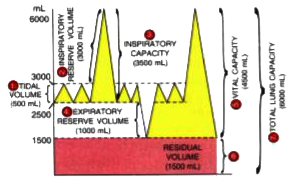Give the definition and normal values of lung volumes and lung capacities.
Step-by-Step Text Solution
1. Definition of Lung Volumes:
- Lung volumes are specific measurements of the amount of air that can be inhaled or exhaled during different phases of breathing. There are four primary lung volumes:
- Tidal Volume (TV): This is the amount of air inhaled or exhaled during a normal breath.
- Normal Value: 500 ml for both men and women.
- Inspiratory Reserve Volume (IRV): This is the amount of air that can be forcibly inhaled after a normal inhalation.
- Normal Value: 3000 ml for men and 2000 ml for women.
- Expiratory Reserve Volume (ERV): This is the amount of air that can be forcibly exhaled after a normal exhalation.
- Normal Value: 1200 ml for men and 700 ml for women.
- Residual Volume (RV): This is the amount of air that remains in the lungs after a maximal exhalation.
- Normal Value: 1200 ml for both men and women.
2. Definition of Lung Capacities:
- Lung capacities are the sum of two or more lung volumes. There are four major lung capacities:
- Inspiratory Capacity (IC): This is the total amount of air that can be inhaled after a normal exhalation, calculated as:
- IC = Tidal Volume + Inspiratory Reserve Volume
- Functional Residual Capacity (FRC): This is the total amount of air remaining in the lungs after a normal exhalation, calculated as:
- FRC = Expiratory Reserve Volume + Residual Volume
- Vital Capacity (VC): This is the total amount of air that can be exhaled after a maximal inhalation, calculated as:
- VC = Tidal Volume + Inspiratory Reserve Volume + Expiratory Reserve Volume
- Total Lung Capacity (TLC): This is the total volume of air in the lungs after a maximal inhalation, calculated as:
- TLC = Vital Capacity + Residual Volume
Summary of Normal Values:
- Lung Volumes:
- Tidal Volume: 500 ml (both)
- Inspiratory Reserve Volume: 3000 ml (men), 2000 ml (women)
- Expiratory Reserve Volume: 1200 ml (men), 700 ml (women)
- Residual Volume: 1200 ml (both)
- Lung Capacities:
- Inspiratory Capacity: TV + IRV
- Functional Residual Capacity: ERV + RV
- Vital Capacity: TV + IRV + ERV
- Total Lung Capacity: VC + RV
- Lung volumes are specific measurements of the amount of air that can be inhaled or exhaled during different phases of breathing. There are four primary lung volumes:
- Tidal Volume (TV): This is the amount of air inhaled or exhaled during a normal breath.
- Normal Value: 500 ml for both men and women.
- Inspiratory Reserve Volume (IRV): This is the amount of air that can be forcibly inhaled after a normal inhalation.
- Normal Value: 3000 ml for men and 2000 ml for women.
- Expiratory Reserve Volume (ERV): This is the amount of air that can be forcibly exhaled after a normal exhalation.
- Normal Value: 1200 ml for men and 700 ml for women.
- Residual Volume (RV): This is the amount of air that remains in the lungs after a maximal exhalation.
- Normal Value: 1200 ml for both men and women.
- Lung capacities are the sum of two or more lung volumes. There are four major lung capacities:
- Inspiratory Capacity (IC): This is the total amount of air that can be inhaled after a normal exhalation, calculated as:
- IC = Tidal Volume + Inspiratory Reserve Volume
- Functional Residual Capacity (FRC): This is the total amount of air remaining in the lungs after a normal exhalation, calculated as:
- FRC = Expiratory Reserve Volume + Residual Volume
- Vital Capacity (VC): This is the total amount of air that can be exhaled after a maximal inhalation, calculated as:
- VC = Tidal Volume + Inspiratory Reserve Volume + Expiratory Reserve Volume
- Total Lung Capacity (TLC): This is the total volume of air in the lungs after a maximal inhalation, calculated as:
- TLC = Vital Capacity + Residual Volume
- Lung Volumes:
- Tidal Volume: 500 ml (both)
- Inspiratory Reserve Volume: 3000 ml (men), 2000 ml (women)
- Expiratory Reserve Volume: 1200 ml (men), 700 ml (women)
- Residual Volume: 1200 ml (both)
- Inspiratory Capacity: TV + IRV
- Functional Residual Capacity: ERV + RV
- Vital Capacity: TV + IRV + ERV
- Total Lung Capacity: VC + RV
Similar Questions
Total lung capacity is
View SolutionTotal lung capacity is :−
View SolutionGiven these lung volumes
View SolutionWhat is the normal value of tidal volume, residual volume, and total lung capacity in man?
View SolutionLung Fluke is
View SolutionLung Fluke is
View SolutionMark the correct order of lung capacities
View SolutionThe volume of air in the lungs and the rate at which it is exchanged during inspiration and expiration was measured.
The following diagram shows a group of the lung volumes and capacities :

Study the diagram carefully and explain briefly the following:
(a) Tidal volume
(b) Inspiratory reserve volume
(c) Expiratory reserve volume
(d) Vital capacity
(e) Residual volume
View SolutionMark the correct order of lung volumes
View SolutionIdentify the incorrect match about lung volumes.
View Solution
